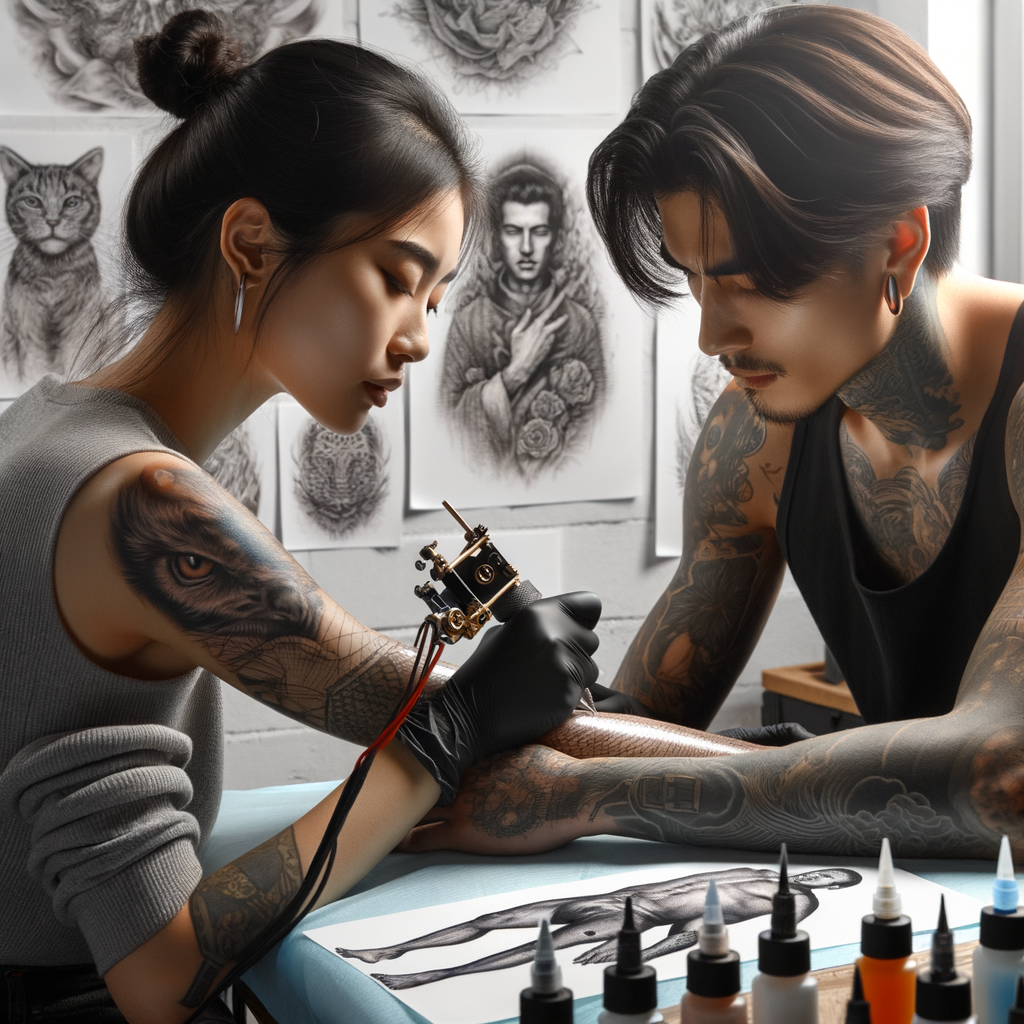
Introduction to Realism Tattoos
Realism tattoos are a fascinating form of body art that has captivated many tattoo enthusiasts worldwide. This blog post will explore the definition, history, and popularity of realism tattoos, providing a comprehensive overview for those interested in this unique tattoo style.
- Definition of Realism Tattoos
- History and Evolution of Realism Tattoos
- Popularity and Acceptance of Realism Tattoos
Realism tattoos, as the name suggests, aim to replicate real-life objects, people, or scenes as accurately as possible. Unlike traditional tattoos, which often use bold lines and bright colors, realism tattoos focus on details, shading, and perspective to create a lifelike image on the skin. They can be in color or black and grey, but the key is the level of detail and the attempt to mimic reality.
Realism as an art movement began in the mid-19th century, but it wasn’t until the late 20th century that it found its way into the tattoo industry. The advent of better tattoo equipment and inks allowed artists to create more detailed and realistic designs. Over the years, realism tattoos have evolved, with artists continually pushing the boundaries of what can be achieved on skin.
Realism tattoos have gained significant popularity in recent years. According to a survey, about 30% of tattoo enthusiasts prefer realism tattoos, making it one of the most popular tattoo styles. This style’s acceptance has also grown, with many viewing it as a legitimate form of art. Realism tattoos have even made their way into mainstream media, with celebrities like Dwayne “The Rock” Johnson and Rihanna sporting realistic tattoos.
In conclusion, realism tattoos are a captivating and intricate form of body art. They represent a blend of artistic skill and personal expression, making them a popular choice for many tattoo enthusiasts. Whether you’re considering getting a realism tattoo or simply appreciate the artistry behind them, understanding their history and significance can enhance your appreciation for this unique tattoo style.
The Artistry Behind Realism Tattoos
Realism tattoos are a unique form of body art that requires a high level of skill and artistry. They are designed to look as lifelike as possible, capturing the smallest details in a stunningly realistic way. Let’s delve into the world of tattoo artistry, the role of artistry in realism tattoos, and explore some famous realism tattoo artists and their works.
- Understanding Tattoo Artistry
- Role of Artistry in Realism Tattoos
- Case Study: Famous Realism Tattoo Artists and their Works
Tattoo artistry is a specialized skill that involves creating designs on the skin using ink and needles. It’s not just about creating a picture on the skin; it’s about understanding the human body, the way the skin moves and stretches, and how ink interacts with it. Tattoo artists must also have a deep understanding of color theory and shading techniques to create depth and dimension in their designs.
The role of artistry in realism tattoos is paramount. These tattoos require a high level of skill and precision. The artist must be able to capture the smallest details, from the subtlest shades of color to the finest lines and textures. This requires not only technical skill but also a keen eye for detail and a deep understanding of the subject being tattooed. Realism tattoos are not just about replicating a photo on the skin; they are about capturing the essence of the subject in a way that is both realistic and artistic.
There are many talented realism tattoo artists around the world, each with their unique style and approach. For instance, Nikko Hurtado is renowned for his color portraits, while Paul Booth is famous for his dark, gothic style. Another notable artist is Steve Butcher, who specializes in hyper-realistic sports and pop culture tattoos. Each of these artists has honed their skills over many years, creating stunning works of art on the skin that are admired by both tattoo enthusiasts and fellow artists.
In conclusion, the artistry behind realism tattoos is a complex and fascinating field. It requires a high level of skill, a keen eye for detail, and a deep understanding of the human body and the art of tattooing. Whether you’re a tattoo enthusiast or just appreciate the art form, there’s no denying the talent and skill that goes into creating these stunning works of art.
Realistic Tattoo Designs
Realistic tattoos are a testament to the skill and artistry of the tattoo artist. They require a keen eye for detail and a deep understanding of how to translate a three-dimensional image onto the skin’s two-dimensional surface. Let’s explore some of the most popular types of realistic tattoo designs.
Types of Realistic Tattoo Designs
There are countless types of realistic tattoo designs, each with its own unique appeal. Here, we will discuss three of the most popular types: portraits, nature-inspired designs, and 3D realism tattoos.
- Portraits
- Nature-inspired Designs
- 3D Realism Tattoos
Portrait tattoos are a beautiful way to honor a loved one or showcase your admiration for a celebrity or historical figure. These tattoos require a high level of skill to accurately capture the person’s likeness. The best portrait tattoos not only resemble the person but also capture their personality and spirit.
Nature-inspired tattoos are perfect for those who feel a deep connection to the natural world. These designs can include anything from a detailed landscape to a single flower or animal. The key to a successful nature-inspired tattoo is realism and attention to detail, making the design come alive on the skin.
3D realism tattoos are a relatively new trend in the tattoo world. They use shading and perspective to create an illusion of depth, making the tattoo appear to be three-dimensional. These tattoos can be incredibly realistic, often looking more like a sculpture than a flat image.
Choosing the right realistic tattoo design is a personal decision that should be made with careful consideration. Whether you opt for a portrait, a nature-inspired design, or a 3D realism tattoo, the most important thing is that the design resonates with you and reflects your unique personality and style.
Choosing the Right Realistic Tattoo Design
When it comes to selecting the perfect realistic tattoo design, there are several factors to consider. It’s not just about choosing a design that looks cool or trendy. It’s about finding a design that resonates with you on a personal level, and that will continue to do so for many years to come.
- Factors to Consider
- Personal Significance: The tattoo should have a personal meaning or significance to you. It could be a representation of a loved one, a cherished memory, or a symbol that represents your beliefs or values.
- Design Complexity: Realistic tattoos are intricate and detailed. Consider the complexity of the design and whether it can be effectively translated into a tattoo.
- Size and Placement: The size and placement of the tattoo can impact how the design looks. Larger designs allow for more detail, but also require more skin space.
- Color or Black and Grey: Decide whether you want a colored tattoo or a black and grey one. Both can create stunning realistic tattoos, but the choice will affect the overall look of your tattoo.
- Consulting with Professional Tattoo Artists
Choosing the right realistic tattoo design involves careful consideration of various factors. Here are some key points to keep in mind:
Professional tattoo artists are masters of their craft. They have the skills and experience to bring your vision to life. Consulting with a professional can help you refine your design and make informed decisions about size, placement, and color. They can also provide valuable advice on how to care for your tattoo to ensure it stays looking its best for as long as possible.
Remember, a tattoo is a lifelong commitment. It’s worth taking the time to choose a design that you will be happy with for years to come. And, with the help of a professional tattoo artist, you can be confident that your realistic tattoo will be a beautiful piece of art that you can proudly display on your skin.
Tattoo Realism Techniques
In the world of tattoo art, realism is a technique that requires a high level of skill and precision. It involves creating tattoos that look as lifelike as possible. Here, we will explore some of the key techniques used in tattoo realism.
Key Techniques in Tattoo Realism
There are several techniques that tattoo artists use to achieve a realistic look. These techniques are essential in capturing the intricate details and depth of the subject. Let’s delve into each one.
- Shading and Coloring
- Detailing and Precision
- Creating Depth and Dimension
Shading and coloring play a crucial role in creating a realistic tattoo. Shading helps to give the tattoo depth and dimension, making it appear more lifelike. Coloring, on the other hand, is used to add vibrancy and realism to the tattoo. It’s important to note that the choice of colors should be carefully considered to match the actual colors of the subject.
Detailing and precision are what set realistic tattoos apart from other styles. Every single detail of the subject, no matter how small, is captured in the tattoo. This requires a high level of precision and a keen eye for detail. A slight mistake can distort the whole image, making it look less realistic.
Creating depth and dimension is another key technique in tattoo realism. This is achieved through the use of shading and perspective. The tattoo artist must understand how light and shadow work to create a sense of depth and three-dimensionality. This technique helps to make the tattoo look as if it’s popping out of the skin.
In conclusion, mastering these techniques is essential for any tattoo artist who wants to specialize in realism. It requires a lot of practice and dedication, but the end result is truly breathtaking.
Learning Tattoo Realism Techniques
Mastering the art of tattoo realism is not an overnight process. It requires dedication, patience, and a lot of practice. Here are two important steps to help you learn and improve your tattoo realism techniques:
- Training and Practice
- Learning from Experienced Tattoo Artists
Just like any other art form, tattoo realism requires a lot of training and practice. It’s not enough to just understand the theory behind it, you need to put it into action. Start by practicing on synthetic skin or fruit. This will help you get a feel for the tattoo machine and understand how to control it. Remember, practice makes perfect. The more you practice, the better you’ll get.
One of the best ways to learn tattoo realism is from experienced tattoo artists. They have been in the industry for years and have a wealth of knowledge to share. Don’t be afraid to ask questions and learn from their experiences. You can also watch them work to understand their techniques and how they create realistic tattoos. This can be a great source of inspiration and learning.
In conclusion, learning tattoo realism techniques is a journey. It requires patience, practice, and learning from those who have mastered the craft. But with dedication and hard work, you can become a skilled tattoo realism artist.
Realism Tattoo Styles
Realism tattoos are a true testament to the skill and artistry of the tattoo artist. They require a keen eye for detail and a deep understanding of how to translate real-life images onto the skin. There are several styles within realism tattoos, each with its unique characteristics. Let’s delve into three popular realism tattoo styles: Black and Grey Realism, Color Realism, and Hyperrealism.
- Black and Grey Realism
Black and Grey Realism is a style that primarily uses black and grey inks. This style is about creating depth and dimension using different shades of black and grey. It’s like a black and white photograph etched onto your skin. The beauty of this style lies in its ability to capture the nuances of light and shadow, creating a lifelike representation of the subject.
- Color Realism
Color Realism, as the name suggests, involves the use of vibrant colors. This style can bring a tattoo to life with its vivid hues and shades. Color realism tattoos can be incredibly detailed, with the artist using color to create depth and dimension, much like in a colored photograph. This style is often used for nature-themed tattoos, such as flowers and animals, where color can add a touch of realism.
- Hyperrealism
Hyperrealism takes realism to the next level. It’s not just about replicating a photo onto the skin; it’s about making the tattoo look so real, you could mistake it for the real thing. Hyperrealism tattoos often look like high-definition photographs, with every detail, from the texture of the skin to the reflection in the eyes, meticulously rendered. This style requires a high level of skill and precision from the tattoo artist.
Each of these styles has its unique appeal and can be chosen based on personal preference and the subject of the tattoo. Whether you prefer the monochromatic elegance of Black and Grey Realism, the vibrant allure of Color Realism, or the striking detail of Hyperrealism, realism tattoos offer a way to carry a piece of art with you wherever you go.
Detailed Tattoos: The Art of Tattooing Realistic Images
When it comes to realism tattoos, the devil is in the details. The process of creating a detailed tattoo is both an art and a science, requiring a keen eye, steady hand, and a deep understanding of the human body. Let’s delve into the importance of details in realism tattoos, the challenges faced in creating such tattoos, and some examples of highly detailed realism tattoos.
- Importance of Details in Realism Tattoos
- Challenges in Creating Detailed Tattoos
- Case Study: Examples of Highly Detailed Realism Tattoos
Details are what make realism tattoos come alive. They provide depth and dimension, transforming a flat image into a lifelike representation. The more detailed a tattoo, the more realistic it appears. This is why tattoo artists spend countless hours studying their subject, practicing their techniques, and refining their designs. Details such as the texture of skin, the play of light and shadow, and the intricate patterns found in nature are all crucial elements in creating a convincing realism tattoo.
Creating a detailed realism tattoo is no easy feat. It requires a high level of skill, patience, and precision. One of the biggest challenges is maintaining the fine details over time. As the skin ages, tattoos can fade and blur, causing the details to lose their sharpness. This is why it’s important to work with a professional tattoo artist who understands the intricacies of the skin and can create a design that will stand the test of time.
Let’s take a look at some examples of highly detailed realism tattoos. One such example is a portrait tattoo. These tattoos are incredibly detailed, capturing every wrinkle, hair, and shadow on the subject’s face. Another example is a nature-themed tattoo, such as a forest or ocean scene. These tattoos require a high level of detail to accurately depict the various elements of the scene, from the texture of the tree bark to the movement of the water. Lastly, there are hyper-realistic animal tattoos. These tattoos are so detailed, they look like a photograph inked onto the skin. The artist must accurately capture the animal’s fur, eyes, and other features to create a convincing representation.
In conclusion, detailed tattoos are a testament to the skill and artistry of the tattoo artist. They require a deep understanding of the subject, a keen eye for detail, and a steady hand. But the result is a stunning piece of art that is as unique as the person wearing it.
Professional Tattoo Artists: Masters of Realism in Tattoo Art
When it comes to the art of realism in tattoos, professional tattoo artists play a crucial role. They are the masters who bring life to the skin with their intricate designs and precise techniques. Let’s delve into the world of these artists and understand their role, skills, and insights.
-
Role of Professional Tattoo Artists in Realism Tattoos
Professional tattoo artists are the backbone of realism tattoos. They are the ones who transform a simple idea into a piece of art that can be worn with pride. Their role involves understanding the client’s vision, creating a design that aligns with it, and then meticulously inking it onto the skin. They must have a keen eye for detail and a steady hand to ensure the tattoo looks as realistic as possible.
-
Key Skills of Professional Tattoo Artists
Being a professional tattoo artist requires more than just artistic talent. It requires a set of specific skills that include:
Skill Description Artistic Ability Artists must have a strong sense of creativity and artistic talent to create unique and realistic designs. Attention to Detail Realism tattoos require a high level of detail. Artists must be able to capture every tiny aspect of the design. Steady Hand Tattooing requires a steady hand to ensure precise lines and shading. Patience Realism tattoos can take hours to complete. Artists must have the patience to work for long periods without rushing. -
Interview: Insights from a Professional Realism Tattoo Artist
We had the opportunity to interview a professional realism tattoo artist, who shared some valuable insights. The artist emphasized the importance of continuous learning and practice. “Realism tattooing is a craft that requires constant honing. Every tattoo is a new challenge, a new opportunity to push your boundaries,” the artist said. They also highlighted the importance of understanding the client’s vision and working closely with them to bring it to life.
In conclusion, professional tattoo artists are the masters of realism in tattoo art. Their role is crucial, their skills are diverse, and their insights are invaluable. They bring life to the skin with their intricate designs and precise techniques, making the art of tattooing a truly magical experience.
Conclusion: The Beauty and Complexity of Tattoo Art Realism
As we reach the end of our exploration into the world of realism tattoos, it’s clear to see that this art form is much more than just ink on skin. It’s a complex and beautiful expression of skill, creativity, and personal identity.
- Recap of Realism Tattoos
- Future Trends in Realism Tattoos
- Final Thoughts on the Artistry Under the Needle
Realism tattoos are a form of body art that strives to replicate real-life images with stunning accuracy. They require a high level of skill and precision from the tattoo artist, and the results can be truly breathtaking. From the intricate details of a person’s face to the vibrant colors of a sunset, realism tattoos bring the world around us to life in a unique and personal way.
As tattoo technology continues to advance, we can expect to see even more impressive examples of realism tattoos in the future. Artists are constantly pushing the boundaries of what’s possible, experimenting with new techniques and styles. In the coming years, we may see realism tattoos that incorporate 3D effects, hyper-realistic color palettes, and even interactive elements.
Realism tattoos are a testament to the incredible talent and creativity of tattoo artists. They transform the human body into a canvas, creating works of art that are as unique as the individuals who wear them. Whether you’re a fan of tattoos or not, it’s hard not to appreciate the skill and artistry that goes into creating these stunning designs.
In conclusion, the world of realism tattoos is a fascinating one, filled with beauty, complexity, and endless possibilities. It’s an art form that truly showcases the incredible things that can be achieved when skill, creativity, and personal expression come together under the needle.






